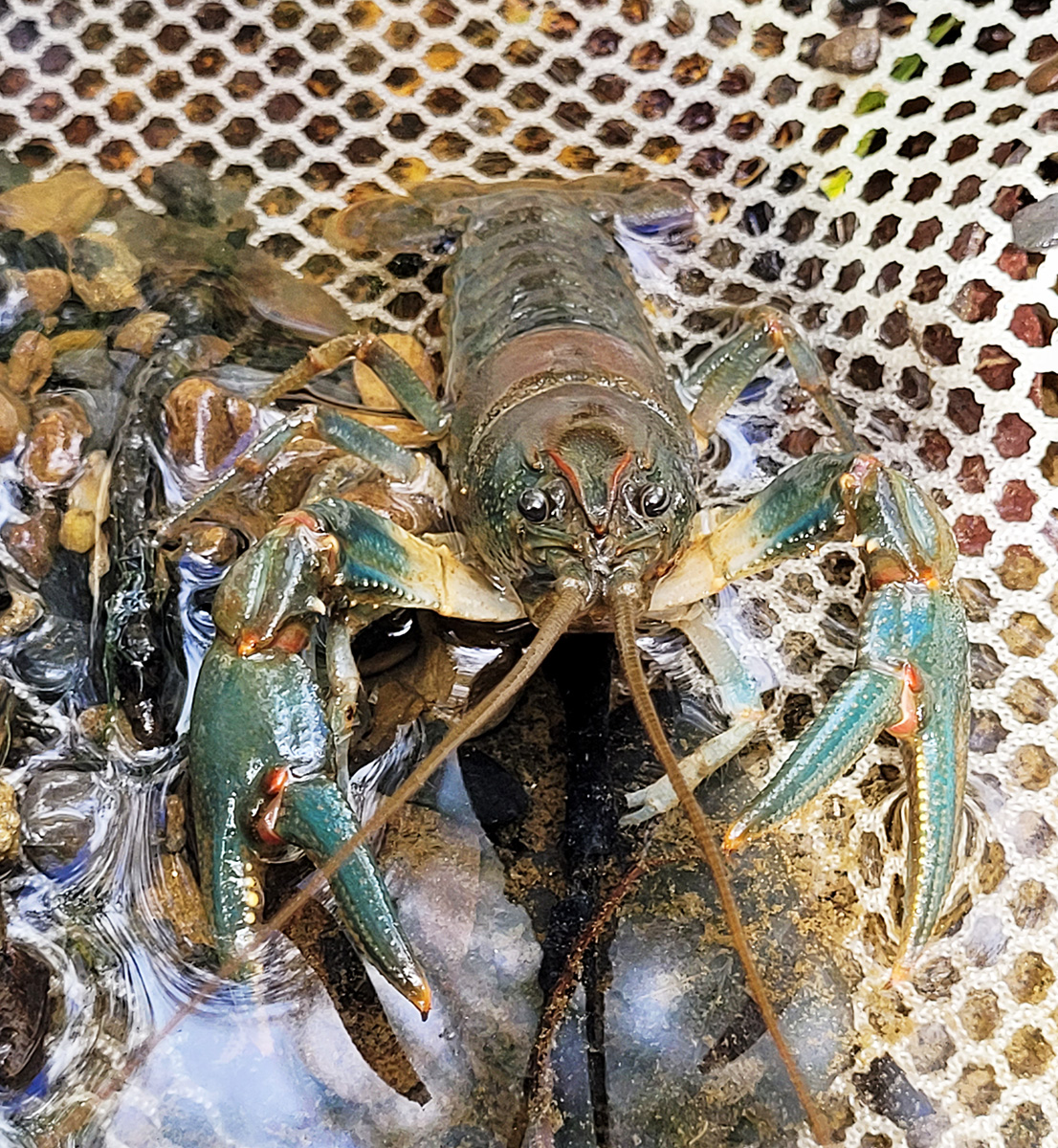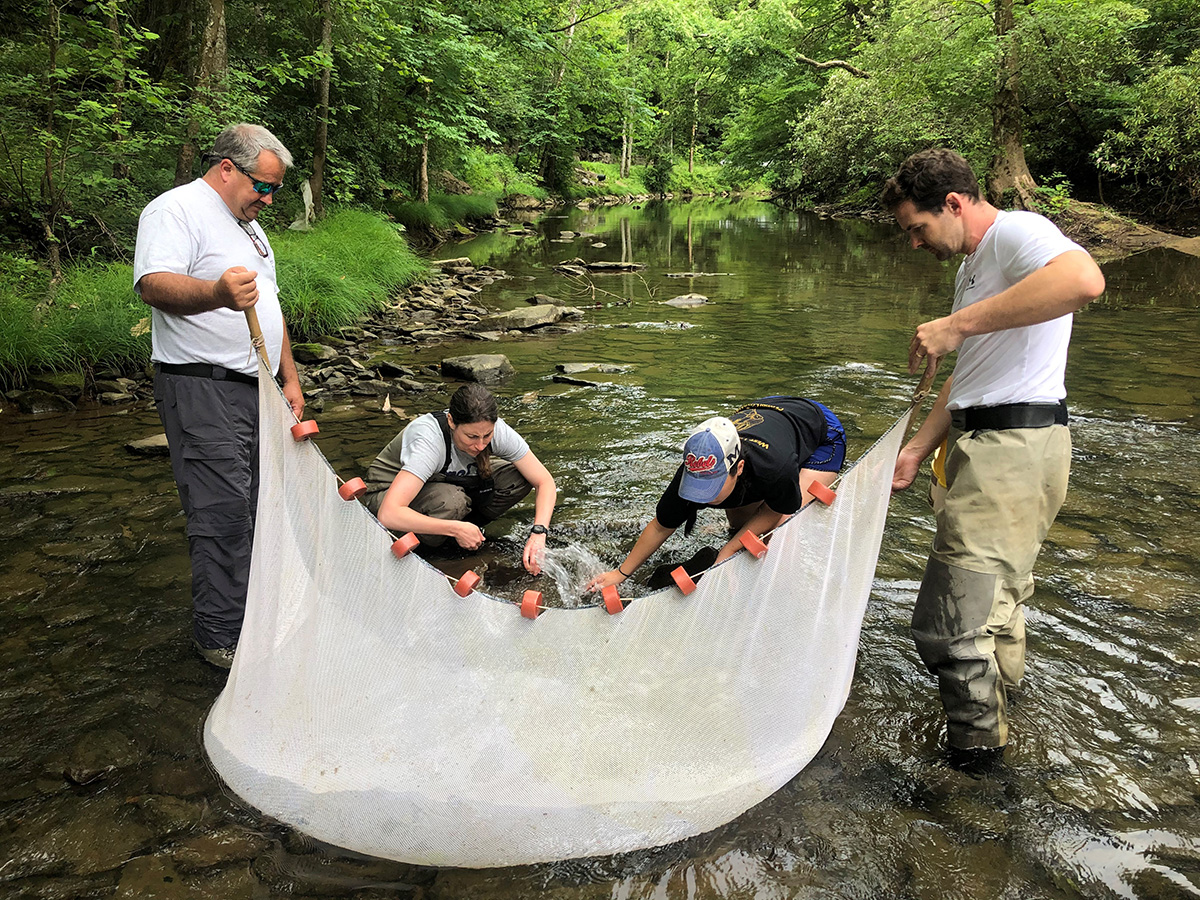By Molly Kirk/DWR
Thanks in part to the Endangered Species Act, there’s work underway to help preserve and expand populations of the Big Sandy crayfish in Virginia. “With the current status, we’re in a really good spot to act immediately, so that we can potentially have some significant positive impacts on the species,” said Brian Watson, aquatic resources biologist and state malacologist for the Virginia Department of Wildlife Resources (DWR).
“We still have good numbers on the landscape when you compare it to something like Appalachian monkeyface (mussel)—that species is much more rare,” Watson said. “There’s not a lot of them, but we do at least have a number of streams that we can routinely go to and get a good number of animals for propagation efforts. Our goal is to try to develop the techniques to propagate and grow these crayfish, and then hopefully release them successfully back into the wild. If we were to wait 10, 15 years, we could be in a situation where the populations are struggling and it’s difficult to find the individuals. So, our hope is to catch the Big Sandy crayfish at the point when it is not quite as imperiled as some of these other species are, so we can have more of a benefit and actually recover them. The goal would be to de-list the crayfish [from the Endangered Species List], but at least conservation activities would help so we don’t see their status decline any further.”

A Big Sandy crayfish. Photo by Zachary Loughman/West Liberty University
The Big Sandy crayfish (Cambarus callainus) is a freshwater crustacean found only in the Big Sandy River basin in Virginia, Kentucky, and West Virginia. Most of the stable populations of the species can be found in the Russell Fork watershed in Virginia, a river system that runs through primarily Wise, Dickenson, and Buchanan counties in Virginia, including through Breaks Interstate Park, and then crosses out of Virginia into Kentucky, where it flows into the Levisa Fork, which eventually joins the Big Sandy River, which forms part of the boundary between Kentucky and West Virginia.
Mind the Gap
Like many species of crayfish, the Big Sandy plays an important role in the aquatic ecosystems it inhabits. “They’re a vital component of the food web,” Watson said. “They’re an ecosystem engineer at the lower levels. They clear out detritus, eating decaying plants and animals, and help pass energy sources up the food chain that might not otherwise be available to the other species, like freshwater fishes. Bass are notorious for feeding on crayfish. You get a lot of anglers putting together lures that look like crayfish because they tend to do fairly well. There are a number of other critters that will eat them if they can get their mouths on them, small mammals and things.”

Big Sandy crayfish play multiple important roles in the aquatic ecosystem. Photo by Brittany Bajo-Walker
Virginia listed the Big Sandy crayfish as state-endangered in 2007, and after extensive population surveys and research, the species was listed as federally threatened in 2016. As for many aquatic species, habitat degradation and loss has had negative effects on population sizes. “A lot of the water quality impacts on the crayfish come from coal mining in southwest Virginia,” said Watson. Sedimentation is also a pressing issue for Big Sandy crayfish, as they require a specific type of habitat— larger flat, slab rocks that are unembedded. They live and breed in the spaces under those rocks.
“If you get significant amounts of sedimentation, it closes up the gaps under those flat rocks and the crayfish don’t have anywhere to live,” said Watson. “There’s also a lack of those size and shape rocks in the rivers. You typically find these rocks in the larger streams out in that area as opposed to smaller streams. Riverbed modification over the years, from flooding, clears some of those large channels of these type of rocks. Sometimes we do surveys in a river like the Levisa Fork and it’s hard to find any of these large, flat rocks left. They’ve all been pushed to the edges or completely removed.”
Signs of Hope
There is good news—when the flat rocks with gaps do exist, the Big Sandy crayfish seems to re-populate the area. “The Big Sandy crayfish hadn’t been seen live in the Levisa Fork since the early 2000s, and we did a limited survey last year and were able to find some individuals in a few spots,” Watson said. “The habitat wasn’t the greatest, but where we found rocks that looked decent and had gaps under them, we were able to turn them up.”
The species’ listing on the Endangered Species List has enabled federal and state agencies to minimize potential development’s impact on their habitat. In addition, funding through the ESA has helped DWR, in partnership with the U.S. Fish and Wildlife Service, the West Virginia Department of Natural Resources, and West Liberty University in West Virginia, to begin a Big Sandy crayfish propagation project at the White Sulphur Springs National Fish Hatchery in White Sulphur Springs, West Virginia.
White Sulphur Springs has worked with the species before, successfully producing the first juvenile Big Sandy crayfish in captivity in 2022, a breakthrough for the recovery of the species and an important steppingstone to future stocking efforts. The DWR project looks to build on that success by expanding the culture systems and further refining the propagation techniques at White Sulphur Springs. “We’re looking to bring in females, and when the females lay eggs, raise the young, and release them back out into the wild to hopefully increase population numbers, or maybe re-introduce the Big Sandy crayfish to streams from which it’s been lost, once conditions are suitable,” said Watson.

DWR staff and partners sample waters with existing Big Sandy crayfish populations in the hopes of finding females to use in a propagation project. Photo by Brian Watson/DWR
There’s also the possibility of doing some habitat restoration work for the Big Sandy since they’re so dependent on their specific type of habitat. “We could propagate all these crayfish, but if they then don’t have the habitat to go into, they’ll start to battle with each other for rock spaces,” Watson explained. “So, that’s the catch with the propagation with these guys versus mussels. Mussels can coexist on a riverbed; crayfish tend fight each other for limited space. If you have limited habitat and you’re putting a bunch of crayfish in these streams, you could be impacting the current population that’s there by overwhelming the available habitat.” DWR has developed an artificial nesting box that’s been successful habitat augmentation for the eastern hellbender species, and Watson thinks eventually a modified version of that nest box might suit the Big Sandy crayfish. But that’s a thought for the future.
Right now, Watson and his DWR team, along with their partners in the project, are hopeful that this summer and fall will see some successfully propagated juvenile Big Sandy crayfish growing at the White Sulphur Springs hatchery. And if all goes well, they could be releasing some of them into the wild in a few years, helping to maintain and grow the population of this unique and essential species in southwest Virginia’s waters.


